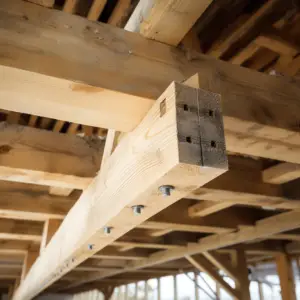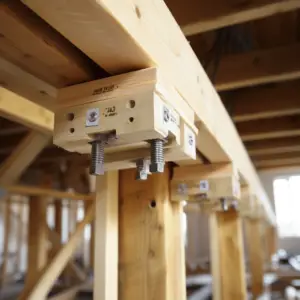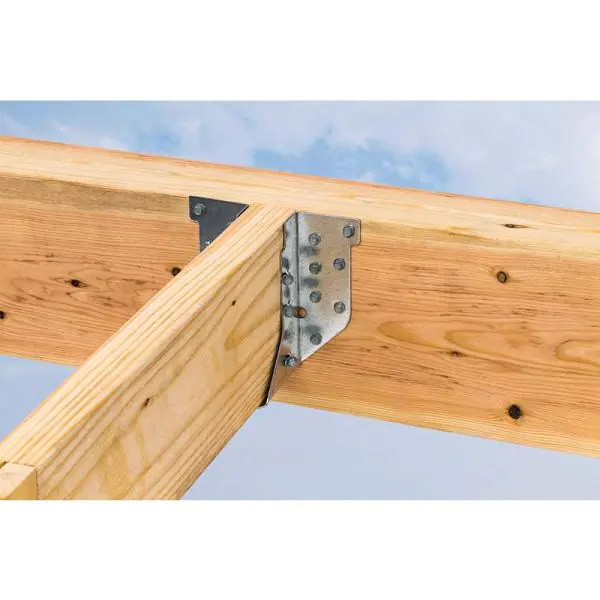Joist Hangers and Beams in Construction, Have you started framing out your structure, and now you’re wondering where to attach the joist? Well, the ideal place to place your joist depends on various factors.
If you decide to use joist hangers, you will need proper reinforcement to ensure that the structure is adequately supported. In addition, when you decide to rest the joist on beams, you will also need strong beams, and the joist should fit into the beam perpendicularly without deficits.
Between Joist hangers and resting on beams, which one is the best? Joist hangers are safe if the installation is done carefully. Structural screws or bolts are safe to help in securing joist hangers to the beam. Only a licensed structural engineer should size the beams.
Typically, when hanging the joists, you need a blocking or rim joist; otherwise, the twisting or wrapping of the joist can make the beam crack.
Do you consider resting joists on a beam? Well, it’s a cheaper option and tends to provide the best performance in terms of tension and resistance. Unfortunately, in some instances, the beam might protrude below the Joist space to distort the general aesthetics of your building. Luckily that can be solved by the use of quality joists and strong beams.
Table of Contents
Joist Hangers and Beams in Construction

The tassel between joist hangers and resting on the beam is never complete without understanding the most crucial terms in the construction industry. Let’s now discuss the two terminologies; Joist and Beam.
For decades, steel has been widely employed as a standard building material in various projects. Industrial buildings, transmission towers, High-rise building skeletons, railway bridges, bridges, and other civil engineering projects are frequent examples.
Typically, the steel structure design needs functional planning based on the structure’s intended use and proper fixing of structural components to carry loads.
Furthermore, the construction framework should be cost-effective and simple to install. Steel, fortunately, can accomplish any required structural effect.
Structural components are important when deciding on a building’s framework. Buildings are framed with joists and beams. Let’s look at the two and see what the differences are.
Joist Hangers Vs Resting On Beam: Overview
What is a Beam?
Beams are mostly the horizontal structural components of a building; however, they can be oriented in any direction. They are huge horizontal components intended to transfer the floor loads from the roofs, walls, or floors to the foundation walls or columns.
The beams directly support the floor joists. Because walls and columns are frequently placed on floors, they may rely on beams indirectly. A beam aims to produce a leveled surface that is accurately straight, even when the structure is at the top of the mudsill. The floor joist system will be supported between the foundation walls.
Beams have historically been constructed from wood or steel, but nowadays, they’re also engineered wood. In a residential building, the terms girder and beam are frequently interchanged.
What is Joist?
Joists can be compared to a series of little beams. They are the horizontal structural elements that span an open area. Joists are similar to beams in function, except they are supported by the beams, foundations, or wall framing.
Joists support a roof or floor by running between walls or rafters. They convey a dead load of floor finishes and subfloor to beams, walls, headers, or foundation walls.
Joist is the backbone of your structure since it carries the weight that the floor is designed to bear. They are technical beams built of wood, engineered wood, or steel that span relatively short lengths compared to beams.
Difference between Joist and Beam

The Joist and Beam Terminology
Beams are the most frequent structural elements used in construction sites to transport loads from floors, walls, or roofs to the foundation walls or columns. They are usually horizontal; however, they can be oriented to fit the function better.
On the other hand, Joists are short beams that span across an open area, usually in a parallel sequence to support a floor or ceiling. Their primary purpose is similar to that of beams, only they act as the skeleton of a structure, spanning horizontally between walls or foundations of a structure.
Sizes
Beams are used to transmit loads to columns or foundations. They may have their loads delivered to them on horizontal or vertical faces. Joists can be connected to the sides of beams or rest on top of them.
The normal beam size is 230 mm x 300 mm. The 9-by-12 inches beam is mostly utilized in residential constructions. A beam might have any size as long as it’s correctly built.
Although no standard ceiling joists are used in residential or industrial structures, most normal residences employ ceiling joists with a board size of 2-by-6 inches. Joist measuring 2-by-12 inches is the biggest one.
Uses
Beams bridge an area with the help of posts and columns, and they work to protect the structural integrity of either industrial or residential buildings. Beams are mostly used in decks, garages, walls, roof, floor, or ceiling.
The joist is smaller than the beam and runs parallel to the horizontal structures like the ceilings, decks, or floor. Joists have a higher strength-to-weight ratio. Therefore, they’re ideal for building multi-storey structures and long-span buildings.
Load-transfer
Roof beams are generally load-bearing members that support the floor and roof above while also adding wall integrity. A collar beam is typically employed to handle horizontal loads in household roof buildings. A rafter roof is the most basic type of roof framework.
On the other hand, joists are horizontal members that transfer the load to vertical members. Roofing joists are typically used to link opposing walls and support the ceiling or floor above them.
The Bottom Line
Generally, a Joist hanger and resting on a beam have a similar function in home construction. They are the crucial structural elements installed on the floor or ground level.
You will bargain between the joist hangers and resting on beams when planning to create a strong roof or floor. In that case, you will consider how the beams and joists work.
Both structural elements differ in size and role. Beams are larger and mostly made from laminated wood, thick solid wood, or any other material. The joist is the single board, often supported by beams aligned perpendicularly to it.


